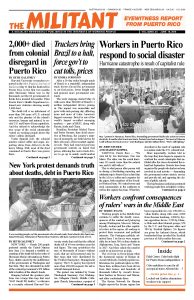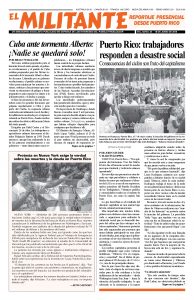Harvard University researchers reported in the New England Journal of Medicine May 31 that the death toll in Puerto Rico in the first two months after Hurricane Maria was in the thousands, not the 64 government officials have insisted for months. Then Puerto Rico’s Health Department released new statistics showing nearly 2,000 died.
The death toll is an indictment of more than 100 years of U.S. colonial rule and the plunder of the island’s resources, human and natural, to enrich U.S. and Puerto Rican capitalists. And the refusal to acknowledge the true scope of the social catastrophe visited on working people shows the rulers’ callous disregard.
Under Spanish rule, the colonial masters raised coffee and sugar, importing slaves from Africa to do the heavy lifting. Still, most of the food consumed in Puerto Rico was grown there.
Washington’s imperialist plunder began in 1898 when U.S. troops wrested control of Puerto Rico — and Cuba — from the Spanish crown, and began twisting the island’s economy to meet their colonial needs.
U.S. capitalists bought up the land, expanded sugar cane and built huge refineries for the home market. By the 1930s sugar production increased 1,200 percent, but less and less food for local consumption was grown. During World War II, U.S. bosses saw Puerto Rico as a source of cheap labor and a market for U.S. goods. In 1947 the U.S. and local government launched Operation Bootstrap, granting across-the-board tax exemptions to U.S. companies to set up there. The first pharmaceutical company, in what became a $60 billion-a-year industry, opened in 1957.
The industrialization accelerated the decline of agriculture. Peasant jíbaros were pushed out of the countryside to work in factories in Puerto Rico and the United States. Today at least 85 percent of the food consumed there is imported. It also marked the beginning of a massive migration to the U.S., more than half a million from 1947 to 1960 alone.
With the rise of the colonial revolution around the world in the 1950s, and then the Cuban Revolution in 1959, Washington’s propaganda machine marketed Puerto Rico as a “showcase of democracy,” the alternative to revolutionary Cuba. It claimed Puerto Rico was a “commonwealth,” not a colony.
But working people have continuously resisted both the Spanish and the U.S. colonizers. The first big rebellion — Grito de Lares in 1868 — intertwined the fight for self-rule with the abolition of slavery. In 1934 tens of thousands of sugar workers went on strike for better wages and conditions and asked Pedro Albizu Campos, the leader of the Nationalist Party, the main pro-independence group, to be their spokesperson.
Worried about the growing support for independence, the colonial regime passed the infamous “Gag Law” in 1947, prohibiting the display of the Puerto Rican flag, the singing of patriotic songs and any discussion of independence. It wasn’t repealed until a decade later.
In October 1950, the Nationalist Party launched the Jayuya uprising. With the help of the National Guard the rebellion was brutally put down.
Successive waves of courageous working-class and independence fighters have been jailed by the U.S. overlords — from Albizu Campos to Rafael Cancel Miranda and Lolita Lebrón to Oscar López, who finally won his freedom in 2017.
U.S. corporations expanded their highly profitable operations in Puerto Rico, fueled by tax breaks from Washington. But as the crisis of capitalism has unfolded, the U.S. rulers phased out most of them. Then the 2006 worldwide capitalist financial crash accelerated the decline. The Puerto Rican government debt to wealthy bondholders mushroomed from $43 billion in 2006 to $74 billion today.
To pay the debt, the colonial government has laid off thousands of public workers, closed schools, raised sales taxes, cut pensions, and cut so far back on maintenance and modernization of the electric system that it was on the verge of collapse even before the hurricane hit. The attacks have deepened after President Barack Obama and the U.S. Congress imposed the unelected Financial Oversight and Management Board to run the island in 2016.
Working people in the U.S. and Puerto Rico “have common interests and struggles — to get the U.S. government and the capitalist ruling class it represents off their back,” Osborne Hart, then Socialist Workers Party candidate for mayor of New York, told the U.N. Special Committee on Decolonization in 2017. “It’s their system that’s responsible for the unprecedented world capitalist crisis we are living through. This disaster comes crashing down harder today on Puerto Rico’s working people and others because of its colonial bondage to Washington.
“Cuba’s socialist revolution shows us what workers and farmers can accomplish when we organize ourselves to take state power out of the hands of the capitalist class, transforming ourselves in the process,” Hart said. “Along that road genuine independence can be won.”

